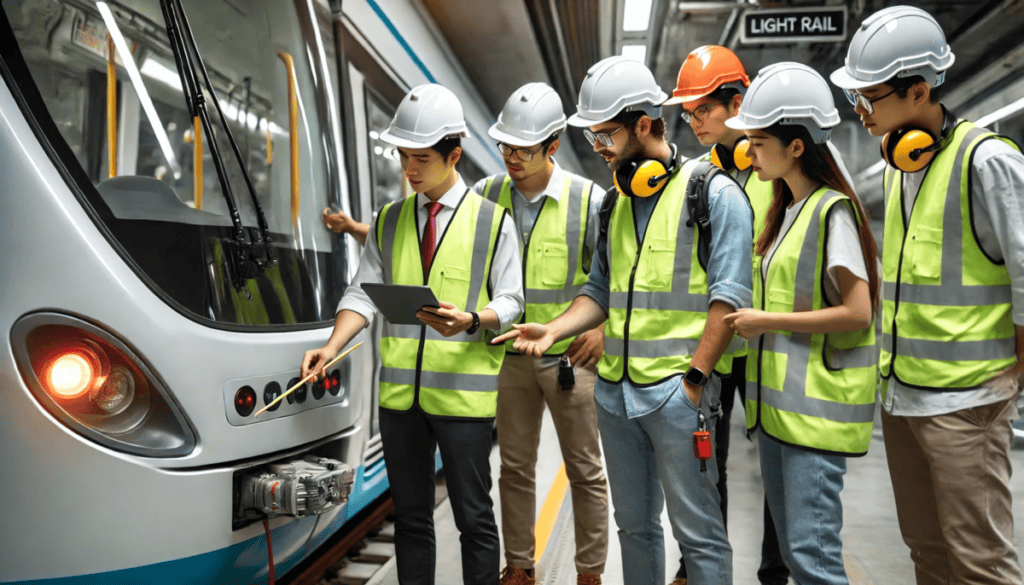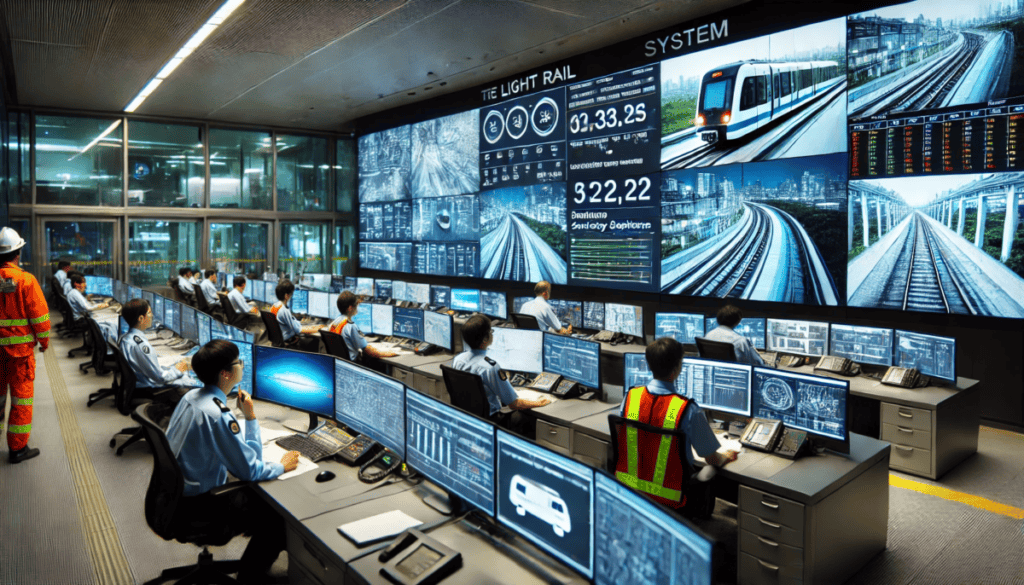Public Transit Safety: The Role of Light Rail Experts

Ensure Public Transit Safety with a Light Rail Expert
Safety in public transit systems is paramount, serving as the foundation for reliable and effective transportation. The significance of safety transcends beyond mere compliance with regulations; it encompasses the protection of passengers, operators, and the general public.
Light rail systems, a critical component of urban transit networks, require rigorous safety measures to prevent accidents and ensure smooth operations. This article delves into the importance of safety in public transit. It highlights the contributions of safety experts, including public transportation safety consultants, light rail safety experts, and rail safety standards experts.
This comprehensive guide explores strategies for improving safety, underscoring the pivotal role of these experts in maintaining and enhancing public transit safety.
Importance of Safety in Public Transit
Safety in public transit is crucial for several reasons. First and foremost, it protects passengers and operators from accidents and injuries. Public transit systems, including light rail, are designed to provide safe, efficient, and reliable transportation. However, the inherent risks associated with transit operations necessitate stringent safety measures.
Common safety challenges in public transit include accidents, equipment failures, and human errors. These incidents can lead to severe consequences, such as injuries, fatalities, and significant financial losses. Moreover, safety incidents undermine public trust in transit systems, leading to decreased ridership and increased scrutiny from regulatory bodies.
Ensuring safety in public transit also has a broader societal impact. Safe transit systems contribute to the overall well-being of communities by providing reliable and accessible transportation options. They also support economic growth by facilitating the movement of people and goods. Therefore, maintaining high safety standards is essential for the sustainability and success of public transit systems.

Role of a Public Transportation Safety Consultant
Contributions of Safety Experts
Public transportation safety consultants are vital in enhancing safety across transit systems. These experts possess specialized knowledge and experience in assessing, developing, and implementing safety protocols. They conduct thorough safety audits, identify potential hazards, and recommend corrective actions to mitigate risks.
Safety consultants also provide training and education to transit staff and operators, ensuring they are well-versed in safety procedures and protocols. This training includes emergency response, incident management, and the proper use of safety equipment. By fostering a safety culture within transit organizations, consultants help prevent accidents and improve overall safety performance.
Case Study: Successful Intervention by a Public Transportation Safety Consultant
These case studies draw on elements that are seen in real cases, but they remain entirely speculative and are used for educational and illustrative purposes.
In a major metropolitan area, a public transportation safety consultant was brought in to address recurring safety issues in the city’s light rail system. Through comprehensive safety audits and risk assessments, the consultant identified several critical areas for improvement, including outdated equipment and insufficient staff training.
By implementing targeted safety measures and conducting extensive training sessions, the consultant significantly reduced the number of accidents and improved the system’s overall safety record.
Expertise of a Light Rail Safety Expert
Light rail safety experts focus specifically on the unique safety challenges of light rail systems. These experts utilize advanced techniques and tools to evaluate and enhance safety.
For instance, they conduct detailed inspections of tracks, vehicles, and signaling systems to identify potential hazards. They also analyze operational data to detect patterns and trends indicating underlying safety issues.
One of the key responsibilities of a light rail safety expert is to develop and implement safety protocols tailored to the specific needs of light rail operations.
These protocols cover various safety aspects, including train operations, maintenance practices, and emergency response procedures. By ensuring that these protocols are rigorously followed, light rail safety experts help prevent accidents and ensure the safe operation of light rail systems.
Case Study: Safety Improvements in a Light Rail System
A light rail safety expert was engaged to address safety concerns in a rapidly expanding light rail network. The expert conducted a thorough analysis of the system’s operations and identified several critical areas for improvement.
By implementing enhanced safety protocols, upgrading signaling systems, and providing targeted training to staff, the expert significantly improved the safety performance of the light rail network. The result was a notable reduction in accidents and incidents, increasing public confidence in the system.
Importance of a Rail Safety Standards Expert
Rail safety standards experts are crucial in establishing and maintaining safety standards within transit systems. These experts are responsible for developing, updating, and enforcing safety standards that align with industry best practices and regulatory requirements.
They ensure that transit systems adhere to rigorous safety standards, thereby minimizing the risk of accidents and ensuring the safety of passengers and operators.
Safety standards experts conduct regular audits and inspections to verify compliance with established standards. They evaluate various aspects of transit operations, including equipment maintenance, operational procedures, and safety protocols.
By identifying areas of non-compliance and recommending corrective actions, these experts help transit systems maintain high safety standards.
Case Study: Implementation of Safety Standards
In a large urban transit system, a rail safety standards expert was tasked with developing and implementing a comprehensive set of safety standards. Through extensive research and collaboration with industry stakeholders, the expert created a robust standards framework that addressed all aspects of transit safety.
By conducting regular audits and providing ongoing support, the expert ensured that the transit system maintained compliance with these standards, resulting in improved safety performance and reduced accident rates.

Implementing Public Transit Safety Strategies
Strategies for Improving Safety
Effective public transit safety strategies involve technology, training, and continuous monitoring. One key strategy is implementing advanced safety technologies, such as surveillance systems, automated safety checks, and real-time monitoring.
These technologies enhance the ability to detect and respond to safety issues promptly, thereby preventing accidents and improving overall safety performance.
Training and education are also critical components of effective safety strategies. Transit staff and operators must be well-trained in safety procedures and protocols to ensure that they can respond effectively to emergencies and prevent accidents. Regular safety drills and refresher courses help reinforce the importance of safety and ensure that staff are prepared to handle various safety scenarios.
Continuous monitoring and evaluation are essential for maintaining high safety standards. Regular safety audits and inspections help identify potential hazards and areas for improvement. By continuously monitoring safety performance and implementing corrective actions as needed, transit systems can ensure that they maintain a high level of safety.
Enhancing Light Rail Safety Protocols
Light rail systems face unique safety challenges that require specific protocols and strategies. One key strategy for enhancing light rail safety is developing and implementing comprehensive safety protocols. These protocols cover various aspects of light rail operations, including train operations, maintenance practices, and emergency response procedures.
Regular safety audits and inspections ensure light rail systems adhere to established safety protocols. These audits help identify potential hazards and areas of non-compliance, allowing transit systems to take corrective actions promptly. By conducting regular inspections and audits, light rail systems can ensure that they maintain high safety standards.
Technology also plays a significant role in enhancing light rail safety. Advanced signaling systems, automated train control, and real-time monitoring technologies help prevent accidents and improve operational efficiency. By leveraging these technologies, light rail systems can enhance safety and provide reliable transportation services.
Transit System Safety Improvements
Continuous improvement is essential for maintaining high safety standards in transit systems. This involves regularly evaluating safety performance, identifying areas for improvement, and implementing corrective actions. Regular maintenance and timely upgrades to infrastructure and vehicles are critical for ensuring transit systems’ safe and efficient operation.
Community engagement and public awareness campaigns are also important for promoting safety. By educating the public about safety protocols and encouraging responsible behavior, transit systems can reduce the risk of accidents and improve overall safety. Engaging with the community helps build trust and fosters a safety culture within the transit system.

Public Transit Safety
Safety is a critical component of public transit systems, ensuring the protection of passengers, operators, and the general public. The contributions of safety experts, including public transportation safety consultants, light rail safety experts, and rail safety standards experts, are essential for maintaining and enhancing safety in transit systems.
Transit systems can ensure that they provide safe, reliable, and efficient transportation services by implementing effective safety strategies, leveraging advanced technologies, and continuously monitoring safety performance.

With over forty years in public transit, Timothy Borchers is a preeminent international transit and light rail expert witness specializing in accident investigation, system safety, and industry compliance. He regularly authors authoritative articles on advanced light rail topics.
